| Listing 1 - 10 of 28 | << page >> |
Sort by
|
Book
ISBN: 9782846541787 2846541787 Year: 2007 Publisher: Paris: Les Indes savantes,
Abstract | Keywords | Export | Availability | Bookmark
 Loading...
Loading...Choose an application
- Reference Manager
- EndNote
- RefWorks (Direct export to RefWorks)
La Société des Missions Etrangères naît au XVIIe siècle, quand se développe en France le désir de prendre une part active à l'apostolat missionnaire.Cet enthousiasme pour les missions correspond au besoin d'établir un clergé indigène, seul capable d'assurer la survie des communautés chrétiennes d'Asie. Le Saint-Siège nomme en 1658 trois vicaires apostoliques français : François Pattu (1626-1684) vicaire apostolique du Tonkin, Pierre Lambert de la Motte (1624-1679) vicaire apostolique de Cochinchine et Ignace Cotolendi (163o-1662) vicaire apostolique de Nankin. Ces évêques sont considérés comme les fondateurs de la Société des Missions Etrangères. Les vicaires apostoliques et les missionnaires qui les accompagnent parviennent au Siam en 1662 ; en 1664, le P. Chevreuil arrive en Cochinchine et, en 1666, le P. Deydier est le premier à entrer au Tonkin. D'autres missionnaires suivent, si bien qu'à la fin du XVIIe siècle, 21 missionnaires ont déjà pénétré soit au Tonkin soit en Cochinchine. Au cours du XVIIIe siècle, la Société des M. -E. est victime en Europe d'une certaine décadence religieuse et d'un désintérêt pour les missions. Le XIXe siècle est au contraire un grand siècle missionnaire. La Société des M. E. compte, en 1886, 29 évêques, 751 missionnaires, avec la charge de 25 missions. Après le Siam, le Tonkin, la Cochinchine, et quelques régions de la Chine et de l'Inde, elle reçoit encore la charge d'évangéliser la Corée et le Japon (1831), la Mandchourie (1838), la Malaisie (1841), le Tibet et l'Assam (1846), la Birmanie (1855). Le XXe siècle est marqué par le développement du clergé local. La direction des diocèses d'Asie passe peu à peu aux évêques autochtones : un évêque indien (1923), six évêques chinois (1926), un évêque japonais (1927), le premier évêque vietnamien (1933). Le communisme change la présence et l'action des Missions Etrangères. Les missionnaires sont expulsés de certains pays (Chine, Birmanie, Vietnam, Cambodge, Laos). Contrainte de redistribuer son personnel, la Société des M. -E. envoie maintenant ses prêtres vers Madagascar, l'île Maurice, l'Indonésie, la Nouvelle-Calédonie. La crise des vocations touche aussi la Société des M. -E. mais, fidèle à sa vocation et malgré un effectif réduit, elle continue, aujourd'hui comme hier, de servir les Eglises qu'elle a contribué à fonder.
Book
ISBN: 9782706705038 2706705035 Year: 2007 Publisher: Paris: Salvator,
Abstract | Keywords | Export | Availability | Bookmark
 Loading...
Loading...Choose an application
- Reference Manager
- EndNote
- RefWorks (Direct export to RefWorks)
Book
Abstract | Keywords | Export | Availability | Bookmark
 Loading...
Loading...Choose an application
- Reference Manager
- EndNote
- RefWorks (Direct export to RefWorks)
Religious studies --- Members of congregations --- Biographical details --- Book --- Experiences --- Flanders --- Belgium
Book
Year: 2007 Publisher: Oxford Oxford University Press
Abstract | Keywords | Export | Availability | Bookmark
 Loading...
Loading...Choose an application
- Reference Manager
- EndNote
- RefWorks (Direct export to RefWorks)
Religious studies --- Art --- Music --- Theatrical science --- History --- International --- Religious communities --- Members of congregations --- Theatre --- Book
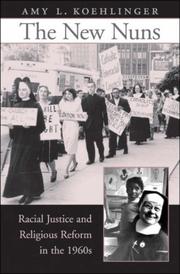
ISBN: 0674024737 9780674024731 0674274377 Year: 2007 Publisher: Cambridge (Mass.) Harvard university press
Abstract | Keywords | Export | Availability | Bookmark
 Loading...
Loading...Choose an application
- Reference Manager
- EndNote
- RefWorks (Direct export to RefWorks)
Nuns --- Vocation (in religious orders, congregations, etc.) --- History --- Selma (Ala.) --- Church history.
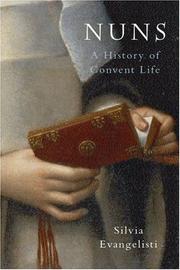
ISBN: 128114679X 9786611146795 0191516864 1429469862 9780191516863 9781281146793 9781429469869 6611146792 0192804359 9780192804358 138300269X Year: 2007 Publisher: Oxford ; New York : Oxford University Press,
Abstract | Keywords | Export | Availability | Bookmark
 Loading...
Loading...Choose an application
- Reference Manager
- EndNote
- RefWorks (Direct export to RefWorks)
Silvia Evangelisti presents the story of the women who have lived in religious communities, from the dawn of the modern age onwards - their ideals and achievements, frustrations and failures, and their attempts to reach out to the society around them.
Monastic and religious life --- Monasticism and religious orders for women --- Nuns --- Sisters (in religious orders, congregations, etc.) --- Christians --- Women in Christianity --- Convents --- Sisterhoods --- Monastic life --- Spirituality (in religious orders, congregations, etc.) --- Monasticism and religious orders --- Spiritual life --- Vows --- History. --- Catholic Church --- Christianity --- Nuns. --- Convents.
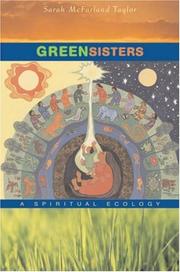
ISBN: 0674027108 9780674027107 0674034953 9780674034952 9780674034952 9780674024403 0674024400 0674267702 9780674267701 Year: 2007 Publisher: Cambridge, MA : Harvard University Press,
Abstract | Keywords | Export | Availability | Bookmark
 Loading...
Loading...Choose an application
- Reference Manager
- EndNote
- RefWorks (Direct export to RefWorks)
Green sisters are environmentally active Catholic nuns working to heal the earth as they cultivate new forms of religious culture. Inviting us into their world, Taylor offers a firsthand understanding of the experiences of women whose lives bring together orthodoxy and activism, and whose lifestyle provides a compelling view of sustainable living.
Human ecology --- Catholic women --- Nuns --- Sisters (in religious orders, congregations, etc.) --- Christians --- Monasticism and religious orders for women --- Women, Catholic --- Christian women --- Religious aspects --- Catholic Church. --- Political activity. --- Religious studies --- Christian religion --- General ecology and biosociology --- Environmental protection. Environmental technology --- United States --- United States of America --- Catholic Church --- Climate --- Members of congregations --- Spirituality --- Book --- Ecology
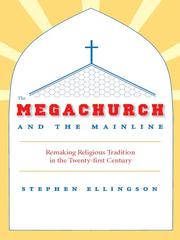
ISBN: 1281956775 0226204928 9786611956776 9780226204925 9781281956774 9780226204895 9780226204901 0226204898 0226204901 Year: 2007 Publisher: Chicago : University of Chicago Press,
Abstract | Keywords | Export | Availability | Bookmark
 Loading...
Loading...Choose an application
- Reference Manager
- EndNote
- RefWorks (Direct export to RefWorks)
Religious traditions provide the stories and rituals that define the core values of church members. Yet modern life in America can make those customs seem undesirable, even impractical. As a result, many congregations refashion church traditions so they may remain powerful and salient. How do these transformations occur? How do clergy and worshipers negotiate which aspects should be preserved or discarded?Focusing on the innovations of several mainline Protestant churches in the San Francisco Bay Area, Stephen Ellingson's The Megachurch and the Mainline provides new
Church renewal. --- Church --- Tradition (Theology) --- Big churches. --- Christian sects. --- Protestant churches. --- Protestant sects --- Christian sects --- Protestantism --- Christian denominations --- Denominations, Christian --- Sects, Christian --- Church history --- Sects --- Christian heresies --- Churches, Big --- Churches, Large --- Congregations, Big --- Congregations, Large --- Large churches --- Megachurches --- Church growth --- Church management --- Church work --- Authority --- Ecclesiastical theology --- Ecclesiology --- Theology, Ecclesiastical --- People of God --- Theology --- Christianity --- Church reform --- Reform of the church --- Renewal of the church --- Religious awakening --- History of doctrines. --- Religious aspects --- Renewal --- Reform --- religion, spirituality, church, christianity, renewal, sociology, religious tradition, lutheranism, protestant, ritual, sect, denomination, megachurch, bay area, san francisco, transformation, evangelism, pragmatism, consumerism, clergy, worship, congregations, hymns, music, service, compromise, nonfiction, mainline, california, secularism, outreach, gospel.
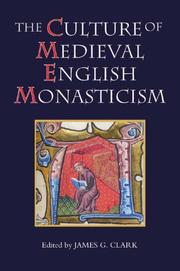
ISBN: 1282185276 9786612185274 1846155304 1843833212 Year: 2007 Publisher: Woodbridge, UK ; Rochester, NY : Boydell Press,
Abstract | Keywords | Export | Availability | Bookmark
 Loading...
Loading...Choose an application
- Reference Manager
- EndNote
- RefWorks (Direct export to RefWorks)
Examinations of the culture - artistic, material, musical - of English monasteries in the six centuries between the Conquest and the Dissolution. The cultural remains of England's abbeys and priories have always attracted scholarly attention but too often they have been studied in isolation, appreciated only for their artistic, codicological or intellectual features and notfor the insights they offer into the patterns of life and thought - the underlying norms, values and mentalité - of the communities of men and women which made them. Indeed, the distinguished monastic historian David Knowles doubted there would ever be sufficient evidence to recover "the mentality of the ordinary cloister monk". These twelve essays challenge this view. They exploit newly catalogued and newly discovered evidence - manuscript books,wall paintings, and even the traces of original monastic music - to recover the cultural dynamics of a cross-section of male and female communities. It is often claimed that over time the cultural traditions of the monasteries were suffocated by secular trends but here it is suggested that many houses remained a major cultural force even on the verge of the Reformation. James G. Clark is Professor of History at the University of Exeter. Contributors: DAVID BELL, ROGER BOWERS, JAMES CLARK, BARRIE COLLETT, MARY ERLER, G. R. EVANS, MIRIAM GILL, JOAN GREATREX, JULIAN HASELDINE, J. D. NORTH, ALAN PIPER, AND R. M. THOMSON.
Monasticism and religious orders --- Monastic and religious life --- History --- History. --- Monastic life --- Spirituality (in religious orders, congregations, etc.) --- Spiritual life --- Vows --- Christianity --- Cultural traditions. --- David Knowles. --- English monasteries. --- Medieval culture. --- Monastic life.
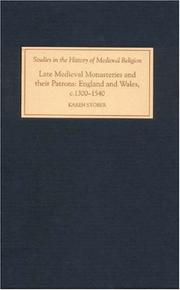
ISBN: 1843832844 9781843832843 9781846155628 9786612185588 1282185586 1846155622 Year: 2007 Volume: 29 Publisher: Woodbridge The boydell press
Abstract | Keywords | Export | Availability | Bookmark
 Loading...
Loading...Choose an application
- Reference Manager
- EndNote
- RefWorks (Direct export to RefWorks)
This book challenges the orthodox view that lay patronage of monasteries dwindled in significance throughout the middle ages. Lay patronage of religious houses remained of considerable importance during the late medieval period; but this is the first full-length study dedicated to the subject. Based on a wide range of medieval documentary sources, including wills, monastic registers, inquisitions post mortem, cartularies and episcopal registers, this book traces the descent of these later patrons and assesses their activities, in particular their bequests and benefactions, their involvement in the affairs of their houses, and their burials in the conventual churches; and it argues that the ties which bound the two parties together, whether amicable, indifferent or abusive, continued right up until the Dissolution brought monastic life in England and Wales to an end. KAREN SToÌBER is a Lecturer in Medieval History at the University of Aberystwyth.
Monasteries --- Patronage, Ecclesiastical --- Monastic and religious life --- Monastères --- Patronage ecclésiastique --- Vie religieuse et monastique --- History. --- History --- Histoire --- 271 <420> "13/15" --- Ordres religieux. Congregations religieuses. Monachisme--Engeland--?"13/15" --- Monastères --- Patronage ecclésiastique --- Ecclesiastical patronage --- Benefices, Ecclesiastical --- Church and state --- Church polity --- Church property --- Clergy --- Monastic life --- Spirituality (in religious orders, congregations, etc.) --- Monasticism and religious orders --- Spiritual life --- Vows --- Cloisters (Religious communities) --- Friaries --- Religious institutions --- Scriptoria --- Christianity
| Listing 1 - 10 of 28 | << page >> |
Sort by
|

 Search
Search Feedback
Feedback About UniCat
About UniCat  Help
Help News
News